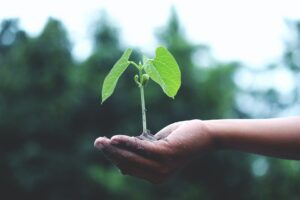Sustainable gardening practices aim to minimize waste, conserve resources, and promote a healthy ecosystem.
By implementing sustainable practices in your garden, you can reduce your environmental impact and create a more sustainable future. In this blog, we’ll explore some sustainable gardening practices you can implement in your garden.
Sustainable Gardening Practices

Composting
Composting is the process of turning organic waste into nutrient-rich soil. By composting your kitchen scraps, yard waste, and other organic material, you can reduce the amount of waste you send to the landfill while creating a valuable resource for your garden. Compost provides plants with essential nutrients and helps to retain moisture in the soil.
Water Conservation
Conserving water in the garden is an essential part of sustainable gardening. Some water conservation practices include:
- Collecting rainwater in barrels for use in the garden
- Installing drip irrigation systems to minimize water waste
- Planting drought-tolerant plants that require less water
- Mulching to retain moisture in the soil
By conserving water in the garden, you can reduce your water usage and create a more sustainable garden.
Organic Gardening
Organic gardening practices involve avoiding the use of synthetic fertilizers and pesticides. Instead, organic gardeners use natural methods to control pests and diseases, such as companion planting, crop rotation, and natural pest repellents. Organic gardening promotes healthy soil, reduces chemical exposure, and supports biodiversity.
Reduce, Reuse, and Recycle
Reducing waste in the garden is an essential part of sustainable gardening. Some ways to reduce waste include:
- Using recycled materials for garden projects
- Repurposing old garden tools and containers
- Using reusable garden labels and markers
- Reducing the use of single-use plastics in the garden
Reducing waste in the garden allows gardeners to create an overall more sustainable and eco-friendly garden.
Plant Native Species
Planting native species in your garden can help to support local ecosystems and promote biodiversity. Native plants are adapted to the local climate and soil conditions, making them easier to grow and maintain. Native plants also provide food and habitat for local wildlife.
Sustainable gardening practices can help to reduce waste, conserve resources, and promote a healthy ecosystem. By composting, conserving water, practicing organic gardening, reducing waste, and planting native species, you can create a more sustainable and eco-friendly garden.
Sustainable Garden Design: Using Garden Planning Software to Create an Eco-Friendly Garden

Garden design is an essential part of creating a sustainable and eco-friendly garden. By using garden planning software, you can create a garden that conserves resources, promotes biodiversity, and reduces waste.
By using Hortisketch, our garden planning software, gardeners can design a sustainable garden and a beautiful and eco-friendly outdoor space. Hortisketch is a fully customizable gardening platform that is dynamic and easy to use.
Incorporating water conservation, using sustainable materials, incorporating native plants, and creating compost areas are just a few ways to make your garden more sustainable. With the help of garden planning software, you can visualize your garden design and make informed decisions about how to create a sustainable garden.
Gardeners grow at Garden Savvy! We provide gardeners with the best tools to plan a garden, organize a garden, and research a garden, with Hortisketch, our Garden Manager and our catalog of gardening Suppliers. Get started on your dream garden today.
Recent Posts
- Smart Gardening: How Technology Is Revolutionizing Horticulture
- Understanding Gardening Zones: What You Need to Know
- The Right Tools For Your Gardening And Landscaping Needs
- Maximizing Your Harvest: Square Foot Gardening Chart for Beginners
- Holiday Garden Scents: Plants for Natural Aromatherapy in Your Home






